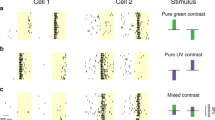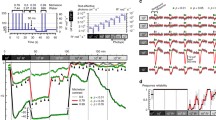Abstract
A mechanistic model is presented that describes the temporal behaviour of a red-green colour opponent channel such as has been investigated for the macaque monkey. The model incorporates luminanceand chromaticity-adaptation mechanisms. Receptive field properties such as retardation and attenuation of the surround signals with respect to the center signals of the colour opponent channel are also included. The model predicts temporal psychophysical chromaticity thresholds and temporal electrophysiological red-green colour opponent ganglion cell behaviour with a reasonable degree of success.
Similar content being viewed by others
References
Benham CM (1895) The artificial spectrum top. Nature 51:113–200
Boynton RM (1979) Human color vision. Holt, Rinehart and Winston, New York
DeValois RL, Abramov I, Mead WR (1967) Single cell analysis of wavelength discrimination at the lateral geniculate nucleus in the macaque. J Neurophysiol 30:415–433
Gouras P, Zrenner E (1979) Enhancement of luminance flicker by color-opponent mechanisms. Science 205:587–589
Ingling CR, Martinez-Uriegas E (1983) Simple-opponent receptive fields are asymmetrical: G-cone centers predominate. J Opt Soc Am 73:1527–1532
Ingling CR, Martinez-Uriegas E (1985) The spatiotemporal properties of the r-g X-cell channel. Vision Res 25:33–38
Koenderink JJ, Grind WA van de, Bouman MA (1971) Foveal information processing at photopic luminances. Kybernetik 8:128–144
Koendrink JJ, Grind WA van de, Bouman MA (1972) Opponent color coding: a mechanistic model and a new metric for color space. Kybernetik 10:78–98
Lange DznH de (1958) Research into the dynamic nature of the human fovea → cortex systems with intermittent and modulated light. J Opt Soc Am 48:777–789
Noorlander C, Koenderink JJ (1983) Spatial and temporal discrimination ellipsoids in color space. J Opt Soc Am 73:1533–1543
Noorlander C, Heuts MJK, Koenderink JJ (1981) Sensitivity to spatiotemporal combined luminance and chromaticity contrast. J Opt Soc Am 71:453–459
Vos JJ (1978) Colorimetric and photometric properties of a 2δ fundamental observer. Col Res Appl 3:125–128
Walraven PL, Leebeek HJ (1964) Phase shift of sinusoidal alternating colored stimuli. J Opt Soc Am 54:78–82
Wyszecki G, Stiles WS (1982) Color science: concepts and methods, quantitative data and formulae. Wiley, New York
Zrenner E (1983) Neurophysiological aspects of colour vision mechanisms in the primate retina. In: Mollon JD, Sharpe LT (eds) Colour vision. Academic Press, London, pp 195–210
Zrenner E, Gouras P (1981) Characteristics of the blue sensitive cone mechanism in primate retinal ganglion cells. Vision Res 21:1605–1609
Author information
Authors and Affiliations
Rights and permissions
About this article
Cite this article
van Esch, J.A., van't Veld, A.A. & Koenderink, J.J. A temporal red-green opponent mechanism. Biol. Cybern. 58, 329–335 (1988). https://doi.org/10.1007/BF00363942
Received:
Accepted:
Issue Date:
DOI: https://doi.org/10.1007/BF00363942




